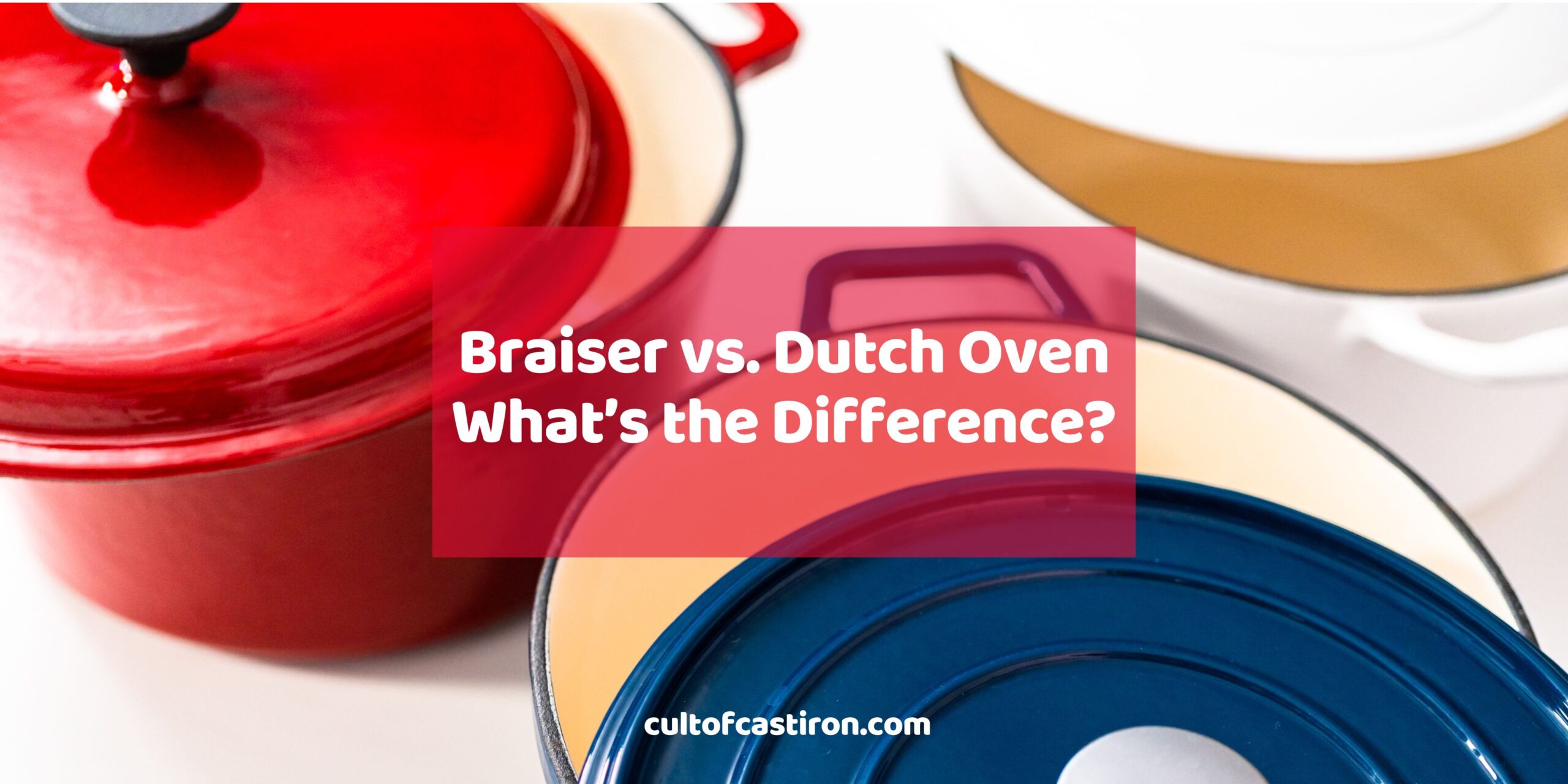Most home cooks are likely familiar with Dutch ovens. These stately and often vibrant statement pieces are the cornerstone of most kitchens. Because of the Dutch oven’s versatility ( and should I say, brand recall), it’s smaller cousin, the braiser, often falls overlooked by the wayside.
And understandably so, as they are essentially from the same genre of cookware. That is: enamel coated, thick-walled pans that are most often used for slow cooking techniques, with the braiser being designed specifically for braising. With that said, while there is a considerable overlap of function and aesthetics between the braiser and the Dutch oven, but are they different enought to warrant having both types of cast iron cookware in your kitchen?
In this article, we’ll explore how the differences and similarities between these two types of cookware, and how to choose one over the other.
What’s the Difference Between a Braiser and Dutch Oven?
While it’s easy to mistake the braiser for a shrunk-down version of a Dutch oven, their differences are more nuanced than that. Here’s a breakdown of how a braiser is physically different to a Dutch oven, and how this influences its practical applications.
Physical Characteristics
Since most everyone here knows what a Dutch oven is, let’s focus the discussion on braisers. But before that, here’s a TL;DR for you skimmers:
| Physical Characteristics | Dutch Oven | Braiser |
|---|---|---|
| Size | Typically larger | Typically smaller |
| Depth | Deeper | Shallower |
| Shape | Round | Oval |
| Walls | Straight | Flared |
Braising is a cooking technique that starts with searing or browning tough cuts of meat and hardy vegetables, then cooking them slowly with a small amount of liquid at a slow temperature for a few hours. The end product is characterized by tender meat, and a rich, flavorful sauce, often made from the reduced cooking liquid. Chew on the reduction bit for a second.
While the same technique can be done on a Dutch oven; both types of cookware have wide and flat bottoms that are excellent for searing and browning food, and both of their lids are heavy and tight-fitting which is essential for trapping steam during the long cooking process. But during the finishing process, when the vessels are often left uncovered, you’ll see that the architecture of a braiser is optimized for quicker evaporation to make the reduction process easier.
The braiser’s shallow nature allow just enough liquid to be placed inside the vessel, which reduces the amount of liquid that has to be reduced in the first place. Moreover, it has flared (or sloped) walls, compared to the typically straight walls of Dutch ovens. Because of this, its top part is typically wider than the bottom – this exposes a larger surface area to air, which promotes quicker evaporation compared to Dutch ovens.
Apart from that, most braisers I see are oval-shaped, as opposed to Dutch ovens that are mostly round-shaped. I think this is more of an aesthetic thing though, and this does not really affect the cooking process that much.
How to Choose Between a Braiser and a Dutch Oven
There is nothing with purchasing both types of cookware. However, if you are in a situation where you have to choose one and one only, then let’s discuss factors that you should consider while making your decision.
Versatility
As I’ve said earlier, there is a considerable overlap of functions between a braiser and a Dutch oven. However, the Dutch oven inherently more versatile as its tall walls will allow you to boil and deep fry food, which cannot be done safely in a shallow vessel like the braiser.
Braiser
- Braising
- Stewing
- Searing
- Simmering
- Roasting
- Baking
- Steaming
Dutch Oven
- Braising
- Stewing
- Searing
- Simmering
- Roasting
- Baking
- Steaming
- Boiling
- Deep Frying
Size and Capacity
It should come to no surprise that Dutch ovens can make more servings of food compared to a braiser. Heck, you can cook a whole chicken in a Dutch oven without breaking a sweat – you can’t do the same in a braiser. This makes the latter better for those who with big families, or those who frequently host dinners and such.
With that said, braisers are great for cooking a sufficient number of portions for a small household. Its smaller size also makes it easier to use for day-to-day cooking. However, it’s no slouch when it comes to cooking meals when entertaining guests as well, but it often plays second fiddle to the Dutch oven. A typical meal would be cooking a creamy batch of polenta in the Dutch oven, while cooking red-wine braised short ribs on the braiser. Or for you fellow Asians out there, you can cook fry a Peking duck on the Dutch oven, while you can steam fish on the braiser.
Conclusion
While there is significant overlap in their capabilities, the choice between a braiser and a Dutch oven often comes down to the volume of food being prepared and the specific cooking technique required. However, there is nothing wrong with using both in the kitchen as they often complement each other when it comes to cooking for a lot of guests.
To learn more about cooking with cast iron, check out Cult of Cast Iron! Scroll through our blog dedicated to all things cast iron and find helpful tips and tricks to level up your cast iron skills! Discover a whole new world of cooking and spread the Cult of Cast Iron word today!

Miguel is a cast iron enthusiast from Cavite, Philippines. He works in the digital marketing field as a content marketing strategist. On the side, he manages a small online bookstore and tends to his plants.


